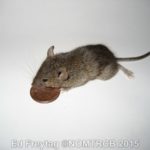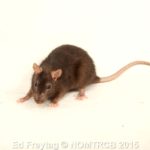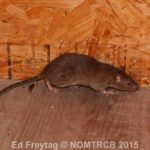General Information
Mice and rats are common problems in and around schools. Rodents cause fires by gnawing on electrical wires, transmit pathogens, and are associated with allergens and asthma triggers. Rodents should not be tolerated in and around schools. Effective, low hazard options are available to eliminate rodents.
Mouse problems can occur at any time of year but especially in the fall when outdoor temperatures begin to cool. Open access points as small as 1/4 inch in diameter for mice 1/2 inch for rats act like beacons, attracting rodents with warm air and food smells. Roof rats prefer areas off the ground and are good climbers. They prosper in attics, roof spaces, and ornamental shrubbery. Roof rats generally enter buildings from overhanging trees or power lines. Norway rats are burrowers and thrive in environments where there is clutter or garbage. They burrow along foundations and under debris. They are good swimmers and may enter buildings through plumbing access points. The home range of these rats may be as much as 50 yards.
The best approach for rodent control takes an integrated pest management (IPM) approach that includes sanitation, exclusion, lethal control, and occupant education. While inspecting, listen for scratching, look for droppings, damage, urine (using a black light), and rub marks. Rodents will forage on a variety of items, so sanitation in addition to exclusion is critical. Rodents can cause damage by chewing wood and other items. They have also been known to start fires by gnawing on electrical wires. They carry many different kinds of diseases and bacteria that can lead to food poisoning. Take precaution when removing nest material, droppings, or remains. Rats are active at night. If they are seen during the day there is likely a large population, scarcity of food, or illness within the population. They defecate wherever they go, so droppings will be spread across their foraging area. Note that Norway rats like to hoard food so they may relocate baits.
Identification
| Species | Image | Basic Biology |
| House Mouse
Mus musculus |
 |
|
| Roof Rat
Rattus rattus |
 |
|
| Norway Rat
Rattus norvegicus |
 |
|
Suggested Thresholds
One rat or mouse or evidence of rodent presence (e.g., fresh droppings, gnaw marks) justifies setting traps, improving sanitation, and rodent proofing the building.
Monitoring and Inspection
Rodent problems typically have obvious signs including droppings and pilfered food for mice and rats and gnaw and grease marks for rats. Grease marks are dark oil stains from rats rubbing against surfaces such as along travel ways, entry points, corners. These signs are most likely to be found along linear pathways including corners between walls and floors, along the base of foundations, and along pipes or electrical conduits. Rats and mice are more likely to be sighted from dusk through dawn.
Mice typically travel 30 feet or less from nesting sites so an intensive search near droppings or other signs will often uncover the nest in wall voids, cardboard boxes, wooden or plastic pallets, heating units, vending machines, appliances, or kitchen equipment.
Norway rats are known to travel approximately 150 feet if food, water, and harborage are adequate, but they can travel up to a mile if stressed. Norway rat burrows are typically found in existing cavities, softer soil, eroded areas adjacent to masonry or rocks, and where hard surfaces such as sidewalks or foundations meet soil. Entry holes are clean and smooth and may have grease marks on any hard edge. Inactive burrows may be obscured by plant growth, spider webs, or debris.
Roof rats are known to travel up to 300 feet in search of food. Roof rats prefer elevated nesting sites including attics, walls, roofs, the tops of palms and other trees, and vine-covered fences and walls.
Rats often become active at dusk and can be seen traveling to food or water sources. Rats are active climbers and swimmers.
Nonchemical Control Measures
Non-chemical control measures that include habitat modification, exclusion, and sanitation are effective in eliminating rodent problems. A mouse can squeeze through a hole the size of a pencil diameter. The first line of defense against mouse problems should include sealing up entry holes; cleaning up clutter inside classrooms, storage, and other areas; and storing items off the floor to allow proper cleaning and inspection. A rat can enter through a 1/2-inch gap. Primary IPM strategies for rats are exclusion, keeping exterior trash handling areas clean, and removing or trimming any vegetation that obscures the ground.
Sanitation/Cultural Control Measures
- Seal any openings greater than 1/4 inch in diameter in foundations, walls, fascia, and roofs. Screen vents and install door sweeps to prevent access. If rats are entering through floor drains, seal these with hardware cloth with mesh smaller than 1/2 inch. Install heavy-gauge kick plates at the base of any doors with evidence of rodent gnawing.
- Remove or trim ground cover and other landscape plants to expose ground and discourage rodent travel ways and rat burrowing. Avoid landscaping that creates ideal habitat for burrows including stone walls with unsealed gaps. Remove mulch from building foundations to reduce harborage. Do not allow grass clippings or leaf litter to accumulate adjacent to school buildings.
- Place exterior trash cans and dumpsters away from building entrances to avoid attracting rodents to building. Use exterior trash receptacles with tight-fitting or spring-loaded lids. Use self-contained, leak-proof compactors instead of Dumpsters, or at least use Dumpsters with tight-fitting lids. Empty exterior trash receptacles daily at the end of each day.
- Fix plumbing leaks and improve drainage to prevent water accumulation near the building. Clean gutters to prevent water retention.
- Remove debris, clutter, or stored materials from the building exterior and adjacent areas to reduce harborage and permit proper cleaning and inspection. Remove clutter and items stored on floors in interior entryways, storage, and other areas to reduce harborage and permit proper cleaning and inspection.
- Place nontoxic monitoring bait blocks in tamper-resistant stations in non-visible, inaccessible areas and check regularly for feeding.
- Visually inspect vulnerable areas often (e.g., food service, custodial closets, laundry rooms, vending areas, garages, under sinks, sill plates, crawlspaces) for droppings or grease marks. Place glue boards, snap traps, shock traps, or live traps in non-visible, inaccessible areas to trap rodents. Clean up droppings, grease marks, and urine promptly using water and district-approved disinfectants. Wear proper personal protective equipment during cleanup.
- Fill in inactive burrows with appropriate filler such as mortar for burrows in or under concrete and soil.
Physical/Mechanical Control Measures
Snap traps, repeating catch-all devices that capture mice, and live traps are all considered physical/mechanical controls for rodents.
Snap traps can be baited with various attractants including food items and cotton string. Peanut butter or honey can be used to stick other foods to the trigger. Snap traps can also be placed in cardboard or plastic boxes designed to hold snap traps. Snap traps should not be used in classrooms unless they are placed in tamper-resistant containers or other areas inaccessible to students. Alternatively, snap traps may be set at night and removed in the morning before students arrive. These should be labeled with a number and marked on a diagram to ensure all are recovered. In TX, it does require a pest control license to place out traps; however, anyone can remove a trap to prevent students or staff from seeing a dead rodent.
Tips for Successful Trapping
- Both roof and Norway rats are leery of new things in their environment, so traps should be in place for several days before being set.
- After being set, traps should remain in place for a week before being moved to a new location.
- Traps should be set along rodent runways to be most effective.
- The trigger side of the trap should be on the wall side.
- Large rodents may move traps so all traps in a school should be secured, even if traps are set on weekends or during holidays.
Tips for Successful Baiting for Snap Traps
- Rodent populations may have a food preference. They may be feeding on ketchup packages or only on bread. If that is the case, you may use those items for bait.
- Roof rats generally prefer fruit and nuts.
- Norway rats prefer fish (sardines) or meat.
- Other baits include chocolate, dry oatmeal or trail mix.
- Peanut butter should be avoided at schools due to potential peanut allergies and it’s not the best attractant.
- Use multiple baits to provide a variety of food choices. For instance, set several traps with chocolate, several with fruit, and several with dry oatmeal.
- Bait some traps with cotton balls or a ball of string. Pregnant females will scavenge for these items to make a nest.
- Remember rats are afraid of new objects (neophobic), so be patient when setting traps and baits.
Chemical Control Measures
When non-chemical measures are inadequate, rodenticides can be used in a manner that greatly reduces potential for non-target exposure. Place bait-block formulations on rods in tamper-resistant bait stations that are secured so that they cannot be easily moved, such as attached to permanent masonry or 40-pound concrete blocks.
Both U.S. EPA and U.S. FDA both have regulations that require the use of tamper-resistant containers when using rodenticides around food handling areas, children, pets, and other non-target wildlife. Specifically EPA requires that rodent baits must be in block, paste, or pelleted forms and require use of tamper-resistant bait stations:
- If bait is to be placed in any indoor or outdoor location to which children under six years-of-age, pets or non-target wildlife have access.
- For all applications made outdoors and above ground, rodenticides must be placed in locking tamper resistant containers
- Baiting of burrows outdoors is permitted only for pelleted baits that are placed at least six inches down active rat burrows.
Rodenticides
First generation anticoagulants kill by preventing blood from clotting and it does take multiple feedings to gain success. The problem with this class of product is that when it was on the market for the public (consumer), children and animals could pick up the poison and ingest it, resulting in injury or death. Now the only way first generation anticoagulants can be used in the consumer market are ready-to-use bait stations that contain and/or are packaged with rodenticide bait that is in block or paste form. This means if you were to go to your local hardware store, you would find this product in one large container and there is no easy way for children or pets to tamper with it. For PMPs to use this product they must place inside tamper resistant container within 100 feet of buildings and other structure and must purchase the rodenticide in containers of 4 pounds or more.
Whereas the first-generation anticoagulants take multiple feedings, the second generation of anticoagulants was created so that rodents who had become resistant to the first gen products would have an alternative permanent solution. Second generation anticoagulants are much faster acting; in some cases, a single night feeding can result in death. However, this is dangerous when it comes to children and pets under the Risk Mitigation Decision. EPA took this class of rodenticide off the consumer market and these products can only be purchased for commercial pest control and structural pest control markets. Products containing second generation anticoagulants must be sold in containers holding at least 16 pounds of bait if they are labeled for use by professional applicators and at least 8 pounds of bait if labeled for use in or near agricultural structures. These registered baits are for use by professional applicators to control rats and/or mice in or within 100 feet of buildings and other structures or for use in and near agricultural buildings and man-made agricultural structures. One item of note is that Vitamin K is considered to be an effective antidote to this type of rodenticide.
There are a couple of non-anticoagulants that require mentioning. Bromethalin is a single dose rodenticide that stops the cells in the nervous system from producing energy. You must be licensed to purchase this product. Cholecalciferol works at producing too much vitamin D; rats must eat several doses to kill them, but this can be dangerous to humans and non-target animals if they are exposed as well. Zinc phosphide is an inorganic compound that combines phosphorus with zinc. When an animal eats the bait, the acid in the animal’s stomach turns the zinc phosphide into phosphine. Phosphine gas blocks cells from making energy which means the heart, brain, kidney and liver fail to work. Products with cholecalciferol and zinc phosphide are classified as restricted use by U.S. EPA. Restricted-use products have the potential to cause unreasonable adverse effects to the environment and injury to applicators or bystanders without added restrictions. The “Restricted Use” classification restricts a product, or its uses, to use by a certified applicator or someone under the certified applicator’s direct supervision.
For more information about rodenticides check out the NPIC website
Always read and follow the label. The label is the law. Pesticides must be used in accordance with federal, state, and local regulations. Applicators must have proper credentialing to apply pesticides and should always wear personal protective equipment (PPE) as required by the pesticide label during applications. All labels and Safety Data Sheets (SDS) for the pesticide products authorized for use in the IPM program should be maintained on file.
Evaluation Methods
Because dead and dying rodents can cause odor and fear, monitoring and control devices should be checked on a daily basis.
Cleanup Precautions
The risk of contact with rodent-associated pathogens and allergens increases when cleaning areas that have been infested with rodents. Maintain good ventilation and avoid stirring up dust. Wetting down the site with a 10 percent bleach solution is recommended for hantavirus prevention. CAUTION: Never use bleach if bird droppings are present because a toxic gas will be produced. Wear the appropriate protective equipment including full-face masks with HEPA filters. For more details, see http://www.cdc.gov/rodents/cleaning/index.htm .
